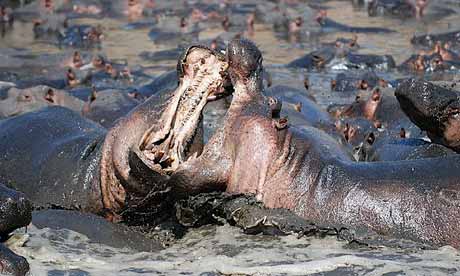
You're more likely to get struck by lightning than eaten by a lion or shark, but what if...? Here we offer you advice for surviving encounters with big beasts
Lions and tigers and bears may sound deadly but, when it comes to large creatures, the most dangerous one is you. In Europe, around 40,000 people are killed and 1.7 million injured each year in road accidents . Forget the antivenom and fasten your seat belts!
Next most hazardous are pets. Dogs injure tens of thousands of people in Britain each year, and about a dozen people are killed in riding accidents annually.
But what dangers do you face from the world’s more exotic species? Here’s an idea of which big critters you need to look out for, and where.
Nile crocodiles kill hundreds – estimates vary between 150 and 1,000 annually. The best thing to do on encountering a croc is run – they’re fast but tire after 10m.
Some say hippos are more dangerous – there have been reports of them upturning boats and charging humans who get between them and the water.
African hunters talked about the Big Five with respect – it was lion, leopard, elephant, buffalo and rhino that would kill you if you botched a shot. But on the whole, these animals won’t attack unprovoked – unless you get between them and a young one, or if you encounter a rare maneater.
Many old Africa hands rate big primates as the most dangerous as they are intelligent, strong and work together.
There are some heavyweights in Asia – a few people die from elephant, bear and even tiger attacks – but it’s snakes that take most lives. Even so, most people who are bitten by snakes in Asia survive. The Indian state of Maharashtra reports 70 bites per 100,000 population and a death rate of 2.4 per 100,000 per year.
The other big meanie in Asia is the estuarine crocodile, which takes victims throughout South and South-East Asia: if locals warn against bathing in certain areas, pay attention! A gruesome story from 1945 tells how 1,000 retreating Japanese soldiers entered the mangrove swamps between Ramree Island and the Burmese mainland; after the salties had finished their feast only 20 were found alive.
Be aware that dog-borne rabies is also a big killer in Asia.
Oz justifiably has a reputation for having some of the nastiest venomous animals in the world, but most are small (spiders, scorpions, etc). The snakes in Oz can be deadly but the medical services are well set-up and ready to deal with envenoming. Estuarine crocodiles have been responsible for 11 deaths over the past 20 years.
Dogs attack almost 5 million US citizens annually, killing between 15 and 20.
There have been recent reports of alligator attacks but these amount to around four incidents a year; most are in Florida, where homes are built too close to the water. The black caiman and American crocodile occasionally kill humans in self defence.
In the Rockies, scavenging bears can be a hazard but www.bear.org assures us that the commonest species – the black bear – is easily chased away. Mountain lions can harm: between 1890 and 1990 there were 53 cougar attacks on humans in the USA and Canada resulting in ten human deaths.
The Americas boast some exceedingly unpleasant and sometimes aggressive snakes; there are nine to 14 deaths a year in the US despite the availability of antivenom; in South America the death toll is higher – for example, it has been estimated at 2,000 a year in Brazil.
Animals can spread disease to humans: rabies causes one or two deaths a year in the US; half of these infections have been acquired from bats.
Europe may seem tame but a few large animals still survive – it’s important to treat any good-sized species (especially domestic stock) with respect. Bears are so scarce in Europe that a bad encounter is unlikely – but they do happen. Wild boars are commoner; they’re also canny, know they are on the menu and nasty if cornered. Wolves know to avoid humans.
Deaths from snake bite in Europe are estimated at 50 per year; www.practicalspain.com estimates the odds of dying from a snake bite in Spain at more than 13.3 million to one.
It is inadvisable to swallow or lick toads in southern Europe (in case that took your fancy). And don’t get too close to a fire salamander – it can squirt a toxic liquid that burns the eyes and can even cause temporary blindness.
There are about 100 incidents, and five deaths, due to sharks each year. The baddies are the bull, tiger, oceanic whitetip, great white, blue, Galápagos and mako species – but this risk should be compared with the 30-100 million sharks slaughtered by humans every year; much of this killing is for shark’s fin soup.
Usually a shark attacks because it has mistaken a swimmer, diver or surfer for its turtle or seal prey. More people die from road accidents, dog bites, drowning, lightning strikes – even falling coconuts.